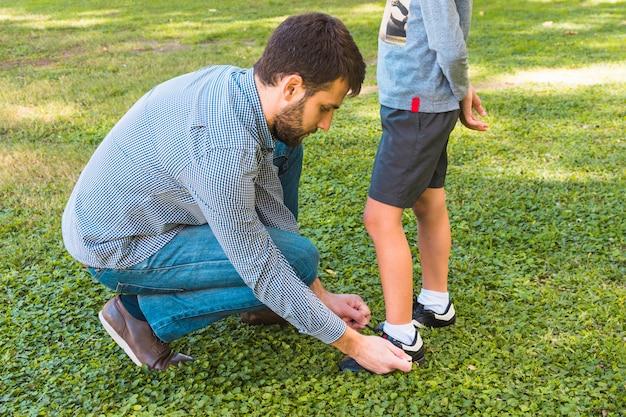Have you ever wondered why players kneel when someone is injured during a sports game? It’s a common sight in many sports, including football, where teammates and even opponents gather around, take a knee, and show concern. But what’s the purpose behind this gesture? In this blog post, we’ll explore the reasons why players kneel, not only when someone gets hurt but also during other key moments in sports. So, let’s dive in and find out why athletes choose to take a knee.
Why Do Players Kneel When Someone Is Injured
When a player gets injured on the field, you may have noticed that the players from both teams gather around and take a knee. Now, you might wonder why they do this. Is it an unwritten rule? Is it just a moment of respect? Well, my friend, it’s actually a lot more than that.
A Moment of Unity and Empathy
When players take a knee after a fellow player is injured, it’s a powerful display of solidarity and support. It’s a way for both teams to come together, regardless of their differences, and show empathy towards their fallen comrade. By kneeling, they are saying, “Hey, we might be opponents on the field, but we are all part of the same community, and we care about each other’s well-being.”
Paying Respect and Showing Sportsmanship
Taking a knee isn’t just about unity; it’s also a sign of respect. In the heat of the game, players often find themselves in intense rivalries, but when an injury occurs, everything else goes out the window. It’s a moment when the competitive nature takes a backseat, and sportsmanship and respect for the game and its players take center stage.
A Pause to Reflect and Regroup
Beyond the symbolism, the act of kneeling also serves a practical purpose. When a player is injured, the game comes to a halt. Taking a knee allows the players to take a moment to collect themselves, catch their breath, and mentally regroup. It’s a brief pause in the midst of the chaos, giving everyone a chance to refocus before play resumes.
A Gentle Nudge to Remind Us of Our Humanity
In a world where sports can sometimes be clouded by controversies and divisions, the act of kneeling when someone is injured is a gentle reminder that, at the end of the day, we are all human beings. It brings a touch of humanity back into the game and reminds us that there are things more important than competition, like empathy, compassion, and solidarity.
So, the next time you witness players taking a knee when one of their own is injured, remember that it’s not just a simple gesture. It’s a profound display of unity, respect, and empathy. It’s a moment that reminds us why we love sports and the incredible power they have to bring us together.
What’s the Point of a QB Kneel
When it comes to football, we all know that it’s not just about throwing the ball and running touchdowns. There’s a whole world of strategy behind every play, including the infamous “QB kneel”. So, what’s the point of a QB kneel? Let’s dive into this seemingly simple play and uncover its hidden depths.
The Art of Running Down the Clock
Imagine this: the game is almost over, the lead is secure, and all you need to do is hold onto the ball. That’s where the QB kneel comes in. It’s a tactic designed to run down the clock and secure the victory. The quarterback takes the snap, drops to one knee, and the clock keeps ticking while the opposing team watches helplessly. It may seem anticlimactic, but it’s a smart move to ensure the win.
An Act of Sportsmanship
But here’s where it gets interesting: the QB kneel isn’t just about running down the clock. It’s also a show of respect and sportsmanship towards the opposing team. When a team kneels, they are essentially saying, “There’s no need to risk injury or push the score further. We acknowledge your effort, and we’ll gracefully end this game.” It’s an unspoken agreement to avoid unnecessary conflict and potential injuries.
Protecting the Quarterback
Let’s not forget that the quarterback is the heart and soul of any team’s offense. The QB kneel allows the team to protect their most valuable player. By taking a knee, the quarterback eliminates the risk of being tackled and potentially injured in the chaos of the game’s final moments. It’s a tactical move that prioritizes the player’s safety while still achieving the team’s goal.
A Time to Reflect and Rethink
Lastly, the QB kneel provides a moment of reflection and reevaluation. As the clock winds down, the team has a chance to reassess their strategy, celebrate their victory, or even learn from their mistakes. It’s a calm before the storm, a quiet moment amidst the excitement, and an opportunity to regroup before the game is officially over.
Wrapping Up
So, the next time you see a QB kneel, remember that there’s more to it than meets the eye. It’s not just a mundane play to finish the game; it’s a strategic move to secure the win, show sportsmanship, protect the quarterback, and reflect on the game. Football is full of surprises, even in its simplest plays.
Why Are Players Taking the Knee
You may have noticed that whenever a player gets injured on the field, their teammates often take a knee. No, they’re not auditioning for a role in a new version of “The Exorcist.” There’s actually a deeper meaning behind this gesture.
Showing Respect and Empathy
When players take a knee, it’s a way for them to show respect and empathy for their injured teammate. It’s their way of saying, “Hey, buddy, we’re here for you. We care about you, and we hope you feel better soon.”
A Moment of Unity
Taking a knee also serves as a moment of unity for the team. It’s a way for players to come together and show solidarity with their injured teammate. Plus, it’s a great opportunity for a quick breather and some team bonding.
Avoiding a “Domino Effect”
Another reason for taking a knee is to prevent a “domino effect” of further injuries. When a player goes down, it’s important for everyone else to stop moving and avoid any potential collisions. So, taking a knee helps ensure that everyone remains safe and reduces the risk of additional injuries.
Misconceptions and Funny Stories
Now, you might be wondering if there are any funny or embarrassing stories related to players taking a knee. Well, let me tell you, there are plenty!
One time, during a particularly intense match, a player took a knee to show support for his fallen teammate. Little did he know, there was a stray banana peel on the field, and he slipped right onto it! Needless to say, it quickly became a memorable moment for everyone involved.
So, the next time you see players taking a knee when someone gets injured on the field, remember that it’s not just about being dramatic or showing off their flexibility. It’s a genuine act of respect, empathy, unity, and yes, even comedy. And now you know why players take a knee.
Why Do People Kneel When Someone Gets Injured
If you’ve ever watched a sports game, you’ve probably noticed that when a player gets injured, everyone on the field suddenly drops to their knees. It might seem odd at first, but there’s actually a good reason behind this seemingly strange tradition.
It’s Not Just About Resting
Contrary to popular belief, players don’t kneel when someone gets injured just to take a break. Although injuries can be physically exhausting, the act of kneeling goes beyond mere rest and relaxation. There’s a deeper meaning to it that ties into the dynamics of sportsmanship and camaraderie.
Showing Respect and Support
When players kneel, it’s a sign of respect and support for the injured player. It’s a way for them to show that they acknowledge the gravity of the situation and that they empathize with their fallen comrade. It’s a gesture that says, “We’re here for you, and we’re rooting for your recovery.”
Unity in the Face of Adversity
Sports, at its core, is a team effort. Each player relies on their teammates for support and encouragement. When an injury occurs, it chips away at the team’s cohesion and can shake the morale of both the injured player and the rest of the team. By kneeling together, players reaffirm their unity and demonstrate that they’re in this challenge together.
A Brief Pause to Reflect
In addition to supporting the injured player, kneeling also serves as a moment of reflection for everyone involved. It’s a pause in the game where players can collect their thoughts, say a silent prayer, or send positive vibes to the injured individual. This brief pause allows players to mentally regroup and regain focus, ultimately benefiting the game as a whole.
The Power of Sportsmanship
Sportsmanship isn’t just about fair play and following the rules. It’s about caring for your teammates, opponents, and the game itself. Kneeling when someone gets injured is a prime example of good sportsmanship. It showcases the compassion and camaraderie that makes sports such a special and beloved aspect of our lives.
It’s More Than a Gesture
While kneeling may be a simple physical act, its significance is profound. It represents empathy, unity, and resilience in the face of adversity. So the next time you see players dropping to their knees when someone gets injured, you’ll understand that it’s not just a casual break or a spontaneous dance move. It’s a powerful expression of support and solidarity in the world of sports.
Why do NFL Players Kneel During the National Anthem
NFL players kneeling during the national anthem has become a hot topic of discussion in recent years. It all started back in 2016 when San Francisco 49ers quarterback, Colin Kaepernick, decided to take a knee during the national anthem to protest against racial injustice and police brutality.
Taking a Stand Against Inequality
The act of kneeling during the national anthem quickly spread throughout the league as other players joined in solidarity with Kaepernick’s cause. It became a powerful symbol of athletes using their platform to bring attention to important social issues.
Uniting for Change
While some critics argue that kneeling during the national anthem disrespects the flag and the men and women who have fought for the country, the players see it as a way to promote unity and demand change. By kneeling, they hope to spark conversations and challenge the status quo, ultimately striving for a more equal and fair society.
A Peaceful Gesture with a Powerful Message
Kneeling during the national anthem is not meant to be an act of defiance but rather an act of peaceful protest. It is a way for players to use their influence to shed light on systemic issues and encourage dialogue that leads to tangible solutions.
Igniting a National Conversation
Love it or hate it, the act of kneeling during the national anthem has undeniably sparked a nationwide conversation about race, inequality, and social justice. It has forced people to confront uncomfortable truths and prompted discussions that may not have happened otherwise.
Respect Through Expression
Contrary to popular misconception, kneeling during the national anthem is not meant to disrespect the flag or the country. The players who choose to kneel are expressing their love for their country and their desire for it to live up to its ideals for everyone, regardless of race or background.
Evolving Perspectives
Over the years, the significance of kneeling during the national anthem has evolved. It has become a symbol of hope, determination, and a demand for change. Players who kneel today do so with the knowledge that they are contributing to a long history of peaceful protests that have helped bring about social progress.
A Chance for Reflection and Growth
While the act of kneeling during the national anthem may be uncomfortable for some, it provides an opportunity for self-reflection and growth. It challenges us to examine our own biases and preconceptions, and to engage in meaningful conversations that can lead to a more inclusive and just society for all.
In conclusion, NFL players kneel during the national anthem to peacefully protest racial injustice and police brutality. Their actions serve as a catalyst for conversations and a call for change. Whether you agree with their methods or not, it is important to understand the motivations behind their actions and to engage in open dialogue to work towards a more equitable future.



